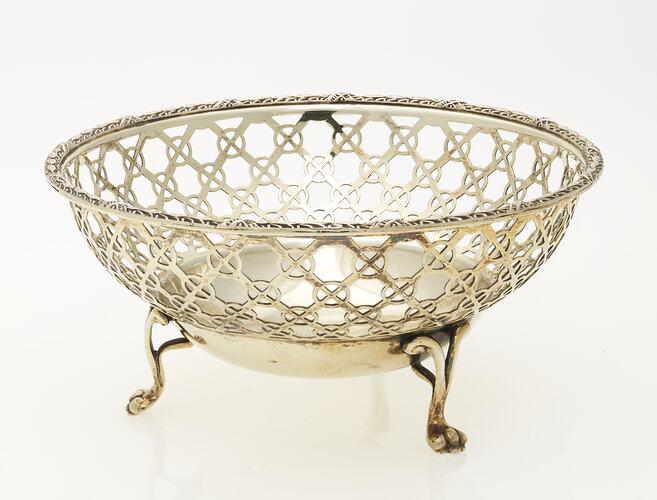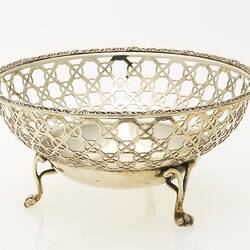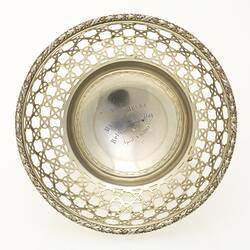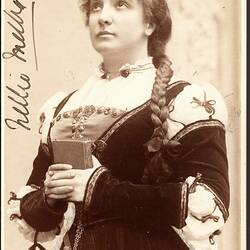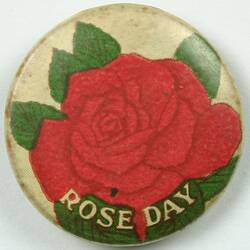Summary
George V sterling silver gilt bowl supported in bifurcated lion paw feet, produced by E.S. Birmingham, 1910. It was presented to Dame Nellie Melba by Belgian Rose Day Committee, 8 April 1915.
In 1915, Melba involved herself in Belgium Rose Day, held in April to raise funds for the citizens of that beleaguered nation. A large number of events were held around Melbourne, and around the state, including a competitive parade of over 50 highly decorated motor cars through the city streets. Melba participated in a fantastical designed creation, based on the swan-drawn vessel featured in Wagner's opera `Lohengrin', one of her favourite performances. `A Woman's Melbourne Letter' article in the Western Mail newspaper (23rd April, 1915) describe the event `(the car) appeared to owe its motion solely to two pure white swans ...... In the front seat, the diva herself sat, (while) in the back, little bare-headed golden curled children, completed a dainty picture. As she passed along, Melba threw flowers amongst the crowd'. Afterwards the Lady Mayoress awarded this bowl to Melba for the best entrant in the procession.
Melba was one Australia's strongest supporters of the various appeals and events held around the country to raise funds for relief charities during World War I. She was personally affected by the War, losing five of her own relations at Gallipoli, as well as many friends in England. Her numerous benefit concerts raised huge sums for local and overseas causes, with countries such as Belgium the immediate focus of her activities. Melba had a particular affection for Belgium having been the location of her operatic debut which set her on her hugely successful operative course. She became a highly visible public figure at this time, both due to her performances and also her patriotic speeches at concerts and in the press, aiming to rouse the Australian public to action. She earned a nickname at this time, the 'Queen of Pickpockets', for never losing an opportunity to extract money from people for the war cause. For her services towards the war effort King George V made Melba Dame Commander of the British Empire. It was a new honour instituted by King George V to reward citizens of the empire for outstanding war work.
Physical Description
Silver gilt bowl, with cast and applied rim surmounting a finely pierced hemispherical body, supported on bifurcated lion paw feet. Inscribed at top centre base.
Significance
Dame Nellie Melba is one of Australia's most famous cultural icons and exports. Her operatic achievements were acknowledged both nationally and internationally and her World War I fundraising efforts earned her Dame Commander of the British Empire. Born Helen Porter Mitchell in Melbourne in 1861, Melba would maintain a constant affection and connection to her homeland and in particular Melbourne and the Yarra Valley where she would establish her Australian home, Coombe Cottage, from 1909. Melba was also a tireless fundraiser, both during World War I, but also for numerous local causes, from hospitals to conservatoriums.
This collection represents Melba as citizen, resident, fundraiser and community participant. They bring together direct connections to Melba with rich stories significant to Melba's broader narrative and to the Museum's collecting areas - such as her World War I fundraising activities, her deeply personal connection to her father David Mitchell, builder of the 1880 Exhibition Building, her attachment to homeland, and her involvement in many local cultural and social activities.
More Information
-
Collecting Areas
-
Acquisition Information
Purchase
-
Acknowledgement
Purchased with the assistance of the Sunshine Foundation and the Australian Government through the National Cultural Heritage Account.
-
Presented To
Dame Nellie Melba, Melbourne, Victoria, Australia, 8 Apr 1915
-
Inscriptions
'Won by/MADAME MELBA/Belgium Rose Day/April 8th 1915'
-
Classification
Recreation & tourism, Performing arts - opera, Awards & presentations
-
Category
-
Discipline
-
Type of item
-
Overall Dimensions
134 mm (Width), 134 mm (Depth), 63 mm (Height)
-
Keywords
Fundraising, Icons, Music, Performers, Opera, Souvenirs, Presentations, Fundraising, Fundraising Events, World War I, 1914-1918, World War I Fundraising
